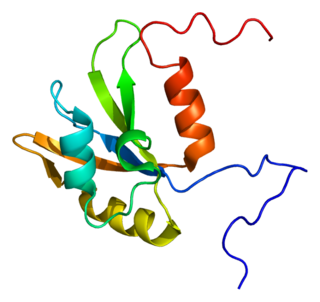
Membrane-bound transcription factor site-1 protease, or site-1 protease (S1P) for short, also known as subtilisin/kexin-isozyme 1 (SKI-1), is an enzyme that in humans is encoded by the MBTPS1 gene. S1P cleaves the endoplasmic reticulum loop of sterol regulatory element-binding protein (SREBP) transcription factors.

Heterogeneous nuclear ribonucleoprotein F is a protein that in humans is encoded by the HNRNPF gene.

Far upstream element-binding protein 1 is a protein that in humans is encoded by the FUBP1 gene.

Far upstream element-binding protein 2 is a protein that in humans is encoded by the KHSRP gene.

AT-rich interactive domain-containing protein 3B is a protein that in humans is encoded by the ARID3B gene.

DNA-binding protein A is a protein that in humans is encoded by the CSDA gene.

DNA-binding protein RFX2 is a protein that in humans is encoded by the RFX2 gene.

Transcription factor RFX3 is a protein that in humans is encoded by the RFX3 gene.

Polypyrimidine tract-binding protein 1 is a protein that in humans is encoded by the PTBP1 gene.

Tropomodulin 2 (neuronal) also known as TMOD2 is a protein which in humans is encoded by the TMOD2 gene.

Gap junction beta-5 protein (GJB5), also known as connexin-31.1 (Cx31.1), is a protein that in humans is encoded by the GJB5 gene.

The E3 ubiquitin-protein ligase Hakai (HAKAI) also known as Casitas B-lineage lymphoma-transforming sequence-like protein 1 (CBLL1) is an enzyme that in humans is encoded by the CBLL1 gene. This gene encodes an E3 ubiquitin ligase for the E-cadherin complex and mediates its ubiquitination, endocytosis, and degradation in the lysosomes. The encoded protein contains a RING-finger domain and is also thought to have a role in control of cell proliferation.

WD repeat and HMG-box DNA binding protein 1 is a protein in humans that is encoded by the WDHD1 gene.

Calpain 6 is a protein in humans that is encoded by the CAPN6 gene.

RIMS binding protein 2 is a protein that in humans is encoded by the RIMBP2 gene.

Transcription factor 15 is a protein that in humans is encoded by the TCF15 gene.

Forkhead box S1 is a protein that in humans is encoded by the FOXS1 gene.

Intraflagellar transport 27 is a protein that in humans is encoded by the IFT27 gene.

Splicing factor proline and glutamine rich is a protein that in humans is encoded by the SFPQ gene.

Forkhead box protein F2 is a protein that in humans is encoded by the FOXF2 gene.




















